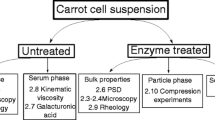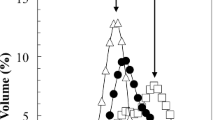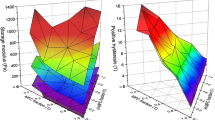Abstract
The effect of particle properties on the rheological behaviour of carrot-derived suspensions was investigated systematically. Hereto, a range of relatively monodisperse suspensions, with varying average particle sizes (∼73, 176, 262 and 369 μm) and pulp contents (from 30 to 65 wt.%), was prepared by the reconstitution of carrot tissue particles in water. Suspensions with average particle size of ∼73 μm consisted of cell fragments, whereas suspensions with larger particle sizes contained mainly cell clusters of which the cell number increased with increasing particle size. The rheological characteristics showed that the carrot-derived suspensions have a non-Newtonian behaviour with a yield stress, depending on particle concentration, size and type. The network structure of all suspensions could be described as a weak gel. Increase in yield stress and storage modulus with particle concentration could be fitted to a power law model. A unique linear relation was found between the yield stress and the plateau modulus, independent of the particle size and type. Particle concentration, size and type appeared to be key structural parameters controlling the rheology of these carrot-derived suspensions. When comparing the rheological behaviour of the reconstituted suspensions with the original carrot purée of similar average diameter and pulp content, the network structure (measured as yield stress or storage modulus) in carrot purée was weaker, which may be attributed to the broader particle size distribution.












Similar content being viewed by others
References
Ahmed, J., Shivhare, U. S., & Raghavan, G. S. V. (2000). Rheological characteristics and kinetics of colour degradation of green chilli puree. Journal of Food Engineering, 44(4), 239–244.
Alviar, M. S. B., & Reid, D. S. (1990). Determination of rheological behavior of tomato concentrates using back extrusion. Journal of Food Science, 55(2), 554–555.
Anthon, G. E., Diaz, J. V., & Barrett, D. M. (2008). Changes in pectins and product consistency during the concentration of tomato juice to paste. Journal of Agricultural and Food Chemistry, 56(16), 7100–7105.
Barnes, H. A. (1999). The yield stress—A review or 'pi alpha nu tau alpha rho epsilon iota'—Everything flows? Journal of Non-Newtonian Fluid Mechanics, 81(1–2), 133–178.
Bayod, E., Bolmstedt, U., Innings, F., & Tornberg, E. (2005). Rheological characterization of fiber suspensions prepared from vegetable pulp and dried fiber: A comparative study. Annual Transactions of the Nordic Rheology Society, 13, 249–253.
Bayod, E., Mansson, P., Innings, F., Bergenstahl, B., & Tornberg, E. (2007). Low shear rheology of concentrated tomato products. Effect of particle size and time. Food Biophysics, 2(4), 146–157.
Bayod, E., & Tornberg, E. (2011). Microstructure of highly concentrated tomato suspensions on homogenisation and subsequent shearing. Food Research International, 44(3), 755–764.
Bayod, E., Willers, E. P., & Tornberg, E. (2008). Rheological and structural characterization of tomato paste and its influence on the quality of ketchup. LWT- Food Science and Technology, 41(7), 1289–1300.
Beresovsky, N., Kopelman, I. J., & Mizrahi, S. (1995). The role of pulp interparticle interaction in determining tomato juice viscosity. Journal of Food Processing and Preservation, 19(2), 133–146.
Bhamidipati, S., & Singh, R. K. (1990). Flow behavior of tomato sauce with or without particulates in tube flow. Journal of Food Process Engineering, 12(4), 275–293.
Buscall, R., McGowan, I. J., Mills, P. D. A., Stewart, R. F., Sutton, D., White, L. R., et al. (1987). The rheology of strongly-flocculated suspensions. Journal of Non-Newtonian Fluid Mechanics, 24(2), 183–202.
Cantu-Lozano, D., Rao, M. A., & Gasparetto, C. A. (2000). Rheological properties of noncohesive apple dispersion with helical and vane impellers: Effect of concentration and particle size. Journal of Food Process Engineering, 23(5), 373–385.
Cheng, D. C. H. (1986). Yield stress—A time-dependent property and how to measure it. Rheologica Acta, 25(5), 542–554.
Coussot, P., & Ancey, A. (1999). Rheophysical classification of concentrated suspensions and granular pastes. Physical Review E, 59(4), 4445–4457.
Day, L., Xu, M., Oiseth, S. K., Hemar, Y., & Lundin, L. (2010). Control of morphological and rheological properties of carrot cell wall particle dispersions through processing. Food and Bioprocess Technology, 3(6), 928–934.
Day, L., Xu, M., Oiseth, S. K., Lundin, L., & Hemar, Y. (2010). Dynamic rheological properties of plant cell-wall particle dispersions. Colloids and Surfaces. B, Biointerfaces, 81(2), 461–467.
Den Ouden, F. W. C., & Van Vliet, T. (1997). Particle size distribution in tomato concentrate and effects on rheological properties. Journal of Food Science, 62(3), 565–567.
Den Ouden, F. W. C., & Van Vliet, T. (2002). Effect of concentration on the rheology and serum separation of tomato suspensions. Journal of Texture Studies, 33(2), 91–104.
Doraiswamy, D., Mujumdar, A. N., Tsao, I., Beris, A. N., Danforth, S. C., & Metzner, A. B. (1991). The Cox–Merz rule extended—A rheological model for concentrated suspensions and other materials with a yield stress. Journal of Rheology, 35(4), 647–685.
Duran, L., & Costell, E. (1982). Rheology of apricot puree—Characterization of flow. Journal of Texture Studies, 13(1), 43–58.
Dzuy, N. Q., & Boger, D. V. (1983). Yield stress measurement for concentrated suspensions. Journal of Rheology, 27(4), 321–349.
Errington, N., Tucker, G. A., & Mitchell, J. R. (1998). Effect of genetic down-regulation of polygalacturonase and pectin esterase activity on rheology and composition of tomato juice. Journal of the Science of Food and Agriculture, 76(4), 515–519.
Farris, R. J. (1968). Prediction of the viscosity of multimodal suspensions from unimodal viscosity data. Transactions of the Society of Rheology, 12(2), 281–301.
Fischer, P., Pollard, M., Erni, P., Marti, I., & Padar, S. (2009). Rheological approaches to food systems. Comptes Rendus Physique, 10(8), 740–750.
Gallegos, C., Franco, J.M. & Partal, P. (2004). Rheology of food dispersions. Rheology Reviews 19–65.
Genovese, D. B., Lozano, J. E., & Rao, M. A. (2007). The rheology of colloidal and noncolloidal food dispersions. Journal of Food Science, 72(2), R11–R20.
Hill, M. A., Mitchell, J. R., & Sherman, P. A. (1995). The relationship between the rheological and sensory properties of a lemon pie filling. Journal of Texture Studies, 26(4), 457–470.
Horwitz, W. (1980). Official methods of analysis of the Association of Official Analytical Chemists (pp. 1–970). Washington: Association of Official Analytical Chemists.
Larson, R. G. (1995). Structure and Rheology of Complex Fluids (pp. 1–663). New York: Oxford University Press.
Lopez-Sanchez, P. (2011). Microstructure and rheological properties of plant particle suspensions prepared using different physical treatments. Ph.D. Thesis, Department of Chemical and Biological Engineering, Chalmers University of Technology, Göteborg, Sweden.
Lopez-Sanchez, P., Nijsse, J., Blonk, H. C. G., Bialek, L., Schumm, S., & Langton, M. (2011). Effect of mechanical and thermal treatments on the microstructure and rheological properties of carrot, broccoli and tomato dispersions. Journal of the Science of Food and Agriculture, 91(2), 207–217.
Lopez-Sanchez, P., Svelander, C., Bialek, L., Schumm, S., & Langton, M. (2011). Rheology and microstructure of carrot and tomato emulsions as a result of high-pressure homogenization conditions. Journal of Food Science, 76(1), E130–E140.
Luckham, P. F., & Ukeje, M. A. (1999). Effect of particle size distribution on the rheology of dispersed systems. Journal of Colloid and Interface Science, 220(2), 347–356.
Mason, T. G., Bibette, J., & Weitz, D. A. (1996). Yielding and flow of monodisperse emulsions. Journal of Colloid and Interface Science, 179(2), 439–448.
Mewis, J., & Macosko, C. W. (1994). Suspension rheology. In C. W. Macosko (Ed.), Rheology principles, measurements and applications (pp. 425–474). New York: VCH.
Mewis, J., & Wagner, N. J. (2011). Colloidal suspension rheology (pp. 1–393). New York: Cambridge University Press.
Mobuchon, C., Carreau, P. J., & Heuzey, M. C. (2009). Structural analysis of non-aqueous layered silicate suspensions subjected to shear flow. Journal of Rheology, 53(5), 1025–1048.
Moller, P. C. F., Mewis, J., & Bonn, D. (2006). Yield stress and thixotropy: On the difficulty of measuring yield stresses in practice. Soft Matter, 2(4), 274–283.
Ovarlez, G., Mahaut, F., Bertrand, F., & Chateau, X. (2011). Flows and heterogeneities with a vane tool: Magnetic resonance imaging measurements. Journal of Rheology, 55(2), 197–223.
Piau, J. M., Dorget, M., & Palierne, J. F. (1999). Shear elasticity and yield stress of silica-silicone physical gels: Fractal approach. Journal of Rheology, 43(2), 305–314.
Qiu, C. G., & Rao, M. A. (1988). Role of pulp content and particle-size in yield stress of apple sauce. Journal of Food Science, 53(4), 1165–1170.
Rao, M. A. (1987). Predicting the flow properties of food suspensions of plant-origin. Food Technology, 41(3), 85–88.
Rao, M. A. (2007). Rheology of fluid and semisolid foods: Principles and applications (pp. 1–462). Washington: Springer.
Rao, M. A., Bourne, M. C., & Cooley, H. J. (1981). Flow properties of tomato concentrates. Journal of Texture Studies, 12(4), 521–538.
Sato, A. C., & Cunha, R. L. (2009). Effect of particle size on rheological properties of jaboticaba pulp. Journal of Food Engineering, 91(4), 566–570.
Schijvens, E. P. H. M., Van Vliet, T., & van Dijk, C. (1998). Effect of processing conditions on the composition and rheological properties of applesauce. Journal of Texture Studies, 29(2), 123–143.
Servais, C., Jones, R., & Roberts, I. (2002). The influence of particle size distribution on the processing of food. Journal of Food Engineering, 51(3), 201–208.
Shih, W. H., Shih, W. Y., Kim, S. I., Liu, J., & Aksay, I. A. (1990). Scaling behavior of the elastic properties of colloidal gels. Physical Review A, 42(8), 4772–4779.
Steffe, J. F. (1996). Rheological Methods in Food Processing Engineering (pp. 1–418). Michigan: Freemann Press.
Tabilo-Munizaga, G., & Barbosa-Canovas, G. V. (2005). Rheology for the food industry. Journal of Food Engineering, 67(1–2), 147–156.
Tanglertpaibul, T., & Rao, M. A. (1987a). Flow properties of tomato concentrates—Effect of serum viscosity and pulp content. Journal of Food Science, 52(2), 318–321.
Tanglertpaibul, T., & Rao, M. A. (1987b). Rheological properties of tomato concentrates as affected by particle-size and methods of concentration. Journal of Food Science, 52(1), 141–145.
Valencia, C., Sanchez, M. C., Ciruelos, A., Latorre, A., Madiedo, J. M., & Gallegos, C. (2003). Non-linear viscoelasticity modeling of tomato paste products. Food Research International, 36(9–10), 911–919.
Varadan, P., & Solomon, M. J. (2003). Direct visualization of long-range heterogeneous structure in dense colloidal gels. Langmuir, 19(3), 509–512.
Yoo, B., & Rao, M. A. (1994). Effect of unimodal particle-size and pulp content on rheological properties of tomato puree. Journal of Texture Studies, 25(4), 421–436.
Yoo, B., & Rao, M. A. (1995). Yield stress and relative viscosity of tomato concentrates—Effect of total solids and finisher screen size. Journal of Food Science, 60(4), 777–779.
Yoo, B., & Rao, M. A. (1996). Creep and dynamic rheological behavior of tomato concentrates: Effect of concentration and finisher screen size. Journal of Texture Studies, 27(4), 451–459.
Zdunek, A., Konskyy, R., Cybulska, J., Konstankiewicz, K., & Umeda, M. (2007). Visual texture analysis for cell size measurements from confocal images. International Agrophysics, 21(4), 409–414.
Acknowledgements
KM is a Ph.D. Fellow and SVB and RC are Postdoctoral Researchers of the Research Foundation Flanders (FWO). In addition, financial support was obtained from the Research Fund K.U. Leuven (KP/08/004 and postdoctoral grant to RJ). Ilse Fraeye is acknowledged for her support during this study.
Author information
Authors and Affiliations
Corresponding author
Rights and permissions
About this article
Cite this article
Moelants, K.R.N., Cardinaels, R., Jolie, R.P. et al. Relation Between Particle Properties and Rheological Characteristics of Carrot-derived Suspensions. Food Bioprocess Technol 6, 1127–1143 (2013). https://doi.org/10.1007/s11947-011-0718-0
Received:
Accepted:
Published:
Issue Date:
DOI: https://doi.org/10.1007/s11947-011-0718-0




